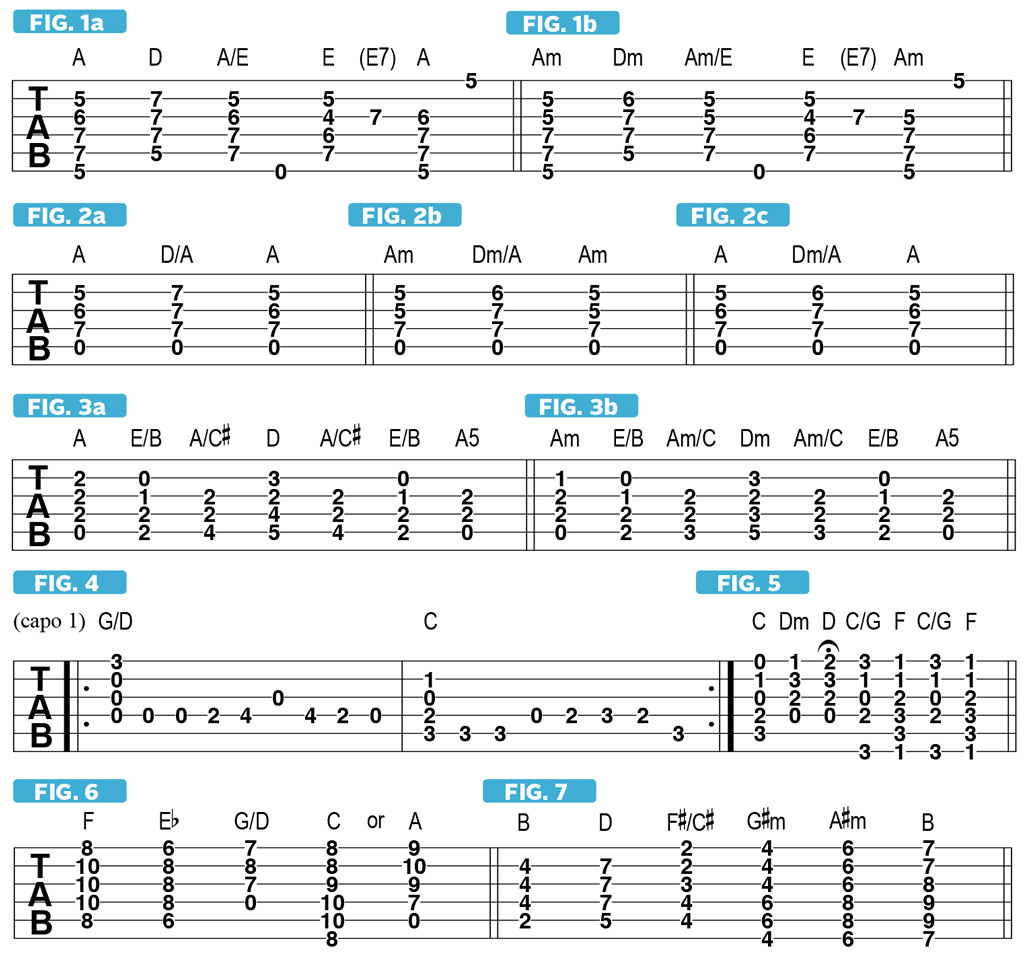Great Applications of a Second-Inversion Chord
Look at a few brief examples of well-known songs that feature the use of a second-inversion chord.
Continuing our examination of ways in which famous songwriters have employed chord inversions to craft the progressions to some of their most celebrated works, I’d now like to cite a few brief, great examples of well-known songs that feature the use of a second-inversion chord, meaning one with the fifth in the bass. But first, let’s look at some basic and traditional applications of this device.
Classical composers, such as Bach, Beethoven and Mozart, commonly employed a second-inversion major or minor chord to set up a final cadence at the end of a section of a piece. FIGURES 1a and 1b illustrate, in the parallel keys of A major and A minor, two examples of this standard move, which has been used so much that it has become a musical cliché, like one of the stock turnaround licks guitarists typically play during the last two bars of a 12-bar blues progression. On the third chord of each figure, the “I” (one) chord is played in second inversion (A/E, or Am/E), which creates an unresolved, suspenseful, “up in the air” kind of sound; this is then followed by the root-position “V” (five) chord, with the E bass note from the previous chord being held over as a common tone and now functioning as the root of the V chord, E or E7. The V, which is major in both examples, then resolves satisfyingly down a perfect fifth (or up a perfect fourth) to the very stable-and very final-sounding root-position I chord.
FIGURES 2a-c demonstrate another standard application of a second-inversion chord in both major and minor contexts, in each case moving from the root-position I chord to the IV, while keeping the same bass note throughout, which functions as a pedal tone and creates a smooth and musically dramatic effect. FIGURES 3a and 3b offer another “classical move,” for which a second-inversion major V chord (the E/B) is used to create a linear “bass-line walk-up” or “walk-down,” likewise demonstrated here in both A major and A minor.

These are traditional ways in which second-inversion chords have been used for hundreds of years. I’d now like to cite examples of novel, non-traditional uses of this musical resource in some of my favorite pop or rock songs from the late 20th century. The first is the intro to Elton John’s beautiful ballad “Someone Saved My Life Tonight,” similar to FIGURE 4, which has us using open G and C chords and a capo at the first fret to conveniently put us in that song’s concert key of Ab major. We begin on the I chord, which is played in second inversion (G/D) and followed by the root-position IV chord (C), with a stepwise bass melody smoothly connecting the two chords in a repeating loop. Again, notice how putting the fifth in the bass creates that “up in the air” sound.
The chorus to “The Night They Drove Old Dixie Down” by the Band features a similar move, here in the key of C. To me, this is one of those beautiful, heart-warming musical moments that gives me goosebumps every time I hear it. FIGURE 5 illustrates the basic chord changes leading up to it.
Two other great examples of a brief but effective use of a second-inversion chord in a rock song are the third chord in the intro to “Something” by the Beatles (again, G/D, as in FIGURE 6) and the third chord in the pre-chorus to “Angel” by Jimi Hendrix, F#, in which bassist Billy Cox plays the fifth of the chord, C#, below the guitar voicing, creating the second inversion’s signature harmonic warmth. FIGURE 7 shows how you can achieve that same sound with just one guitar.
Senior Music Editor "Downtown" Jimmy Brown is an experienced, working guitarist, performer and private teacher in the greater NYC area whose professional mission is to entertain, enlighten and inspire people with his guitar playing.
Get The Pick Newsletter
All the latest guitar news, interviews, lessons, reviews, deals and more, direct to your inbox!
Over the past 30 years, Jimmy Brown has built a reputation as one of the world's finest music educators, through his work as a transcriber and Senior Music Editor for Guitar World magazine and Lessons Editor for its sister publication, Guitar Player. In addition to these roles, Jimmy is also a busy working musician, performing regularly in the greater New York City area. Jimmy earned a Bachelor of Music degree in Jazz Studies and Performance and Music Management from William Paterson University in 1989. He is also an experienced private guitar teacher and an accomplished writer.










![Joe Bonamassa [left] wears a deep blue suit and polka-dotted shirt and plays his green refin Strat; the late Irish blues legend Rory Gallagher [right] screams and inflicts some punishment on his heavily worn number one Stratocaster.](https://cdn.mos.cms.futurecdn.net/cw28h7UBcTVfTLs7p7eiLe.jpg)
